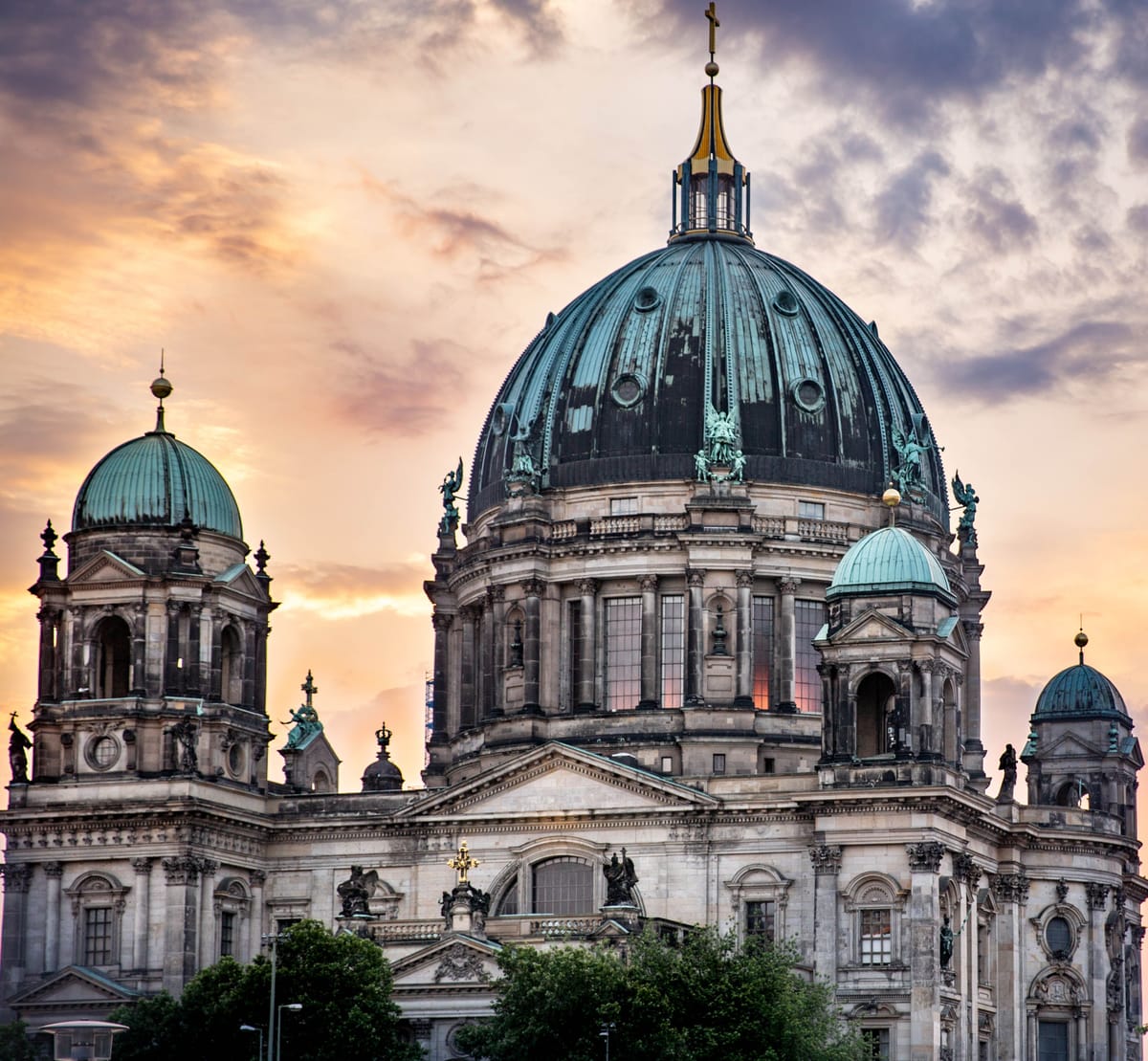Plan Your Trip to Berlin: What to Know Before You Go!
When planning a trip to Berlin, choosing the right area of the city to stay in, based on what you want to do and the attractions you want to see, is crucial for a convenient trip. This guide will make it stress-free and easy to plan your trip to Berlin.

In this Berlin City Guide, you'll learn everything you need to know before you go—covering all the aspects that are usually the least fun part of planning any trip.
We’ll discuss the neighborhoods you might want to stay in, each area’s proximity to the most popular attractions, and how easy it will be to get around and explore Berlin from that location.
So, if you are planning your trip to Berlin, bookmark this page! It will let you do the fun part—choosing what to see and do—while confidently picking lodging that will be convenient for your plans.
Most Popular Attractions in Berlin
- Brandenburg Gate - An iconic symbol of Berlin and German reunification, this neoclassical monument is one of the city's most famous landmarks.
- Berlin Wall Memorial - A preserved section of the Berlin Wall that stands as a reminder of the city's divided past, complete with an outdoor exhibition.
- Museum Island - A UNESCO World Heritage site featuring five world-renowned museums, including the Pergamon Museum and the Neues Museum.
- Reichstag Building - The historic parliament building with a glass dome offering panoramic views of the city, symbolizing transparency in government.
- Checkpoint Charlie - The most famous crossing point between East and West Berlin during the Cold War, now a popular tourist spot with a museum.
- East Side Gallery - A 1.3-kilometer-long section of the Berlin Wall that has been turned into an open-air gallery, showcasing murals by artists from around the world.
- Berlin Cathedral (Berliner Dom) - A magnificent Baroque cathedral located on Museum Island, with a stunning dome and impressive interior.
Best Neighborhoods to Stay in Berlin
Berlin is a city of contrasts—historic landmarks, edgy street art, world-class food, and neighborhoods that each tell their own story. Whether you’re after luxury, nightlife, or affordability, these are the top areas to consider for your stay in Berlin.
Mitte (Best for First-Time Visitors)
Mitte sits right in the heart of Berlin, making it ideal if you want to be close to the city’s biggest attractions. You’ll be able to walk to places like the Brandenburg Gate, Museum Island, and the Berlin Cathedral—all within 10–15 minutes. It’s also home to countless restaurants, boutique hotels, and historical landmarks, so you can pack a lot into your days without ever straying far.
Average Distance to Attractions:
- Brandenburg Gate, Reichstag Building, and Checkpoint Charlie — all 10–15 minutes on foot
- East Side Gallery — 15 minutes by train
Kreuzberg (Best for Nightlife & Street Culture)
Kreuzberg is where Berlin’s creative energy thrives. It’s packed with street art, independent cafes, and a nightlife scene that stretches until sunrise. You’re about 10–15 minutes by train from Museum Island, Brandenburg Gate, and Berlin Cathedral, while Checkpoint Charlie is walkable.
This area is perfect if you love a mix of culture and chaos—think international food markets by day and rooftop bars by night.
Prenzlauer Berg (Best for Families & Food Lovers)
Once gritty, now charmingly bohemian, Prenzlauer Berg is full of leafy streets, cozy brunch spots, and stylish boutiques. It’s a quieter option that still keeps you connected—just 10–20 minutes by tram or train to Berlin’s top sights like Museum Island, Berlin Wall Memorial, and Brandenburg Gate.
This is a great base for couples or families wanting a more relaxed stay without feeling too far from the action.
Charlottenburg (Best for Luxury & Shopping)
Charlottenburg is elegant, historic, and upscale. You’ll find high-end hotels, Charlottenburg Palace, and Berlin’s famous shopping boulevard, Kurfürstendamm. It’s around 20–25 minutes by train to most central attractions such as Museum Island, Brandenburg Gate, and Berlin Cathedral.
If you’re looking for a refined experience—think fine dining, museums, and stylish streets—this is your spot.
Friedrichshain (Best for Young Travelers & Nightlife)
Located just east of the river, Friedrichshain is where Berlin’s alternative edge meets post-industrial charm. You can walk to the East Side Gallery in under 15 minutes, while other attractions like the Brandenburg Gate and Reichstag Building are only about 20 minutes away by train.
Expect energetic bars, budget-friendly stays, and plenty of creative spaces that give Berlin its famous grit-meets-glam personality.
Neukölln (Best for Budget Travelers & Artists)
Neukölln is one of Berlin’s most diverse areas, filled with vintage shops, art collectives, and multicultural eateries. You’re about 20–30 minutes by train from top attractions like the Brandenburg Gate and Museum Island, but you’ll pay far less for accommodation compared to central districts.
It’s perfect if you want a local experience in a neighborhood that’s evolving fast but still affordable.
Moabit (Best for Central Access on a Budget)
Moabit often flies under the radar, but it’s incredibly well connected. Just 10–15 minutes by bus to places like the Reichstag Building and Brandenburg Gate, it gives you easy access to Berlin’s main attractions without the central price tag.
Expect quieter streets, local cafes, and a mix of modern apartments and traditional architecture.
Wedding (Best for an Authentic Local Stay)
Wedding is an up-and-coming neighborhood known for its cultural diversity and low prices. You’re about 10–20 minutes by train from Museum Island, Brandenburg Gate, and the Berlin Wall Memorial.
This is where you’ll find authentic local spots, community events, and a real taste of everyday Berlin—away from the tourist buzz.
Grunewald (Best for Peace & Nature)
Set on the city’s western edge, Grunewald offers luxurious villas, forest trails, and lakeside tranquility. It’s about 30–40 minutes from Berlin’s main attractions by train, but if you prefer nature and quiet sophistication, it’s unbeatable.
Expect scenic walks, cycling routes, and easy access to Grunewald Forest and Teufelsberg Hill.
How to Choose Where to Stay
Not sure which Berlin neighborhood fits your style? Here’s a quick glance to help you decide:
- Mitte — Best for first-time visitors who want to stay near major attractions like the Brandenburg Gate and Museum Island.
- Charlottenburg — Great for travelers who prefer a central yet upscale area with elegant hotels, fine dining, and top shopping streets.
- Kreuzberg — Perfect for nightlife lovers and those who want a creative, multicultural vibe with great food and music scenes.
- Friedrichshain — Ideal for younger travelers seeking energetic nightlife, affordable stays, and the East Side Gallery within walking distance.
- Neukölln — A solid pick for budget-conscious travelers who want a trendy, artistic neighborhood away from tourist crowds.
- Moabit — Best for those who want central access without the high prices—great transport links and a more local feel.
- Wedding — Perfect for travelers seeking an authentic Berlin experience with affordable accommodations and a laid-back atmosphere.
- Grunewald — Best for peace and nature lovers looking for a quiet retreat surrounded by forests and lakes.
Getting Around The City (Transportation)
Berlin offers a comprehensive public transportation system that includes trains, buses, trams, and taxis, making it easy to navigate the city.
- Trains (U-Bahn & S-Bahn): Berlin’s U-Bahn (subway) and S-Bahn (suburban train) networks are extensive, covering nearly every part of the city. Trains are frequent and efficient, ideal for getting around quickly.
- Buses: Berlin’s bus network complements the train system, especially in areas not well served by the U-Bahn or S-Bahn. Buses run regularly and are a reliable option for shorter distances.
- Trams: Particularly useful in the eastern parts of the city, trams are another great way to explore Berlin, especially in areas like Prenzlauer Berg and Friedrichshain.
- Rideshare Apps: Uber operates in Berlin, and it’s a convenient option for getting around the city, especially in areas where public transport is less accessible.
Trams, U-Bahn, and S-Bahn Stations in Berlin Neighborhoods
- Mitte Neighborhood
- U-Bahn Stations: Alexanderplatz (U2, U5, U8), Friedrichstraße (U6)
- S-Bahn Stations: Hauptbahnhof (S3, S5, S7, S9), Friedrichstraße (S1, S2, S25)
- Kreuzberg
- U-Bahn Stations: Mehringdamm (U6, U7), Kottbusser Tor (U1, U8)
- S-Bahn Stations: Anhalter Bahnhof (S1, S2, S25)
- Prenzlauer Berg
- U-Bahn Stations: Eberswalder Straße (U2)
- S-Bahn Stations: Schönhauser Allee (S41, S42, S8, S85)
- Trams: Excellent coverage with lines M1, M2, M10 running frequently.
- Charlottenburg
- U-Bahn Stations: Zoologischer Garten (U2, U9), Wilmersdorfer Straße (U7)
- S-Bahn Stations: Charlottenburg (S3, S5, S7, S9)
- Friedrichshain
- U-Bahn Stations: Warschauer Straße (U1, U3)
- S-Bahn Stations: Ostkreuz (S3, S41, S42, S5, S7, S75, S85), Warschauer Straße (S3, S5, S7, S9)
- Trams: Frequent service with lines like M10 connecting Friedrichshain to other areas.
- Neukölln
- U-Bahn Stations: Hermannplatz (U7, U8), Rathaus Neukölln (U7)
- S-Bahn Stations: Neukölln (S41, S42, S45, S46)
- Moabit
- U-Bahn Stations: Turmstraße (U9)
- S-Bahn Stations: Westhafen (S41, S42, S46), Bellevue (S3, S5, S7, S9)
- Wedding
- U-Bahn Stations: Wedding (U6)
- S-Bahn Stations: Wedding (S41, S42, S46)
The Cost of Public Transportation in Berlin
- Single Ticket: €3.20 for AB zone (central Berlin), valid for 2 hours on all forms of transport.
- Day Ticket: €9.70 for AB zone, valid until 3 a.m. the following day.
- Weekly Ticket: €38.00 for AB zone, unlimited travel for 7 days.
- Berlin WelcomeCard: Starting at €25 for 48 hours, includes unlimited public transport and discounts on attractions.
You can purchase tickets at vending machines in stations or via the BVG mobile app: BVG Tickets.
I hope this guide helps you easily plan your trip to Berlin. With all the essential information at your fingertips, you can now focus on enjoying everything this incredible city has to offer. Safe travels, and enjoy your time in Berlin!
